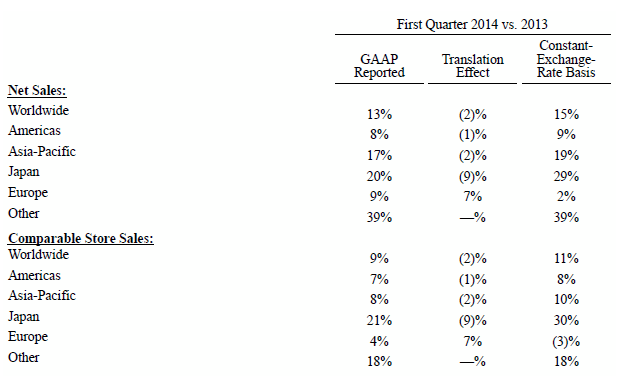
Source: Wikimedia Commons
After reporting better-than-anticipated revenue and earnings for the first quarter of its 2014 fiscal year on May 21, shares of Tiffany & Company (TIF +0.00%) shot up more than 9%. With the company's stock trading around a new 52-week high, is now the time to consider an investment in Signet Jewelers (SIG 0.47%) instead, or does Tiffany have what it takes to keep soaring higher?
Tiffany blew past estimates!
For the quarter, Tiffany reported revenue of $1.01 billion. In addition to beating the $955.05 million analysts anticipated, the company's sales were a whopping 13% greater than the $895.48 million management reported the same quarter a year earlier. Even though Tiffany saw its growth rate come in at 8% in its Americas region, its performance in both its Asia/Pacific and Japan operations proved more impressive.
According to the company's earnings release, Tiffany saw sales climb 17% in its Asia/Pacific business to $261 million. This was driven by a 10% improvement in comparable store sales that was led by the company's strong results in Greater China and Australia. Japan's numbers were even better! For the quarter, the company saw a 20% sales growth to $174 million in the region, driven by a 30% jump in comparable store sales (excluding foreign currency fluctuations).
Another growth driver for the company was its dedication to opening new locations. While comparable store sales globally grew 9% for the quarter, it was the 6% jump in store count from 275 stores last year to 292 this year that carried its revenue the rest of the way.

Source: Tiffany & Company
From a revenue perspective, Tiffany did quite well, but its bottom line was even better. For the quarter, the business saw earnings per share come in at $0.97. This was significantly higher than the $0.78 Mr. Market wanted to see and represented a 49% increase compared to the $0.65 the company reported during the first quarter of 2013.
On top of benefiting from higher sales, the business saw meaningful reductions in its cost structure during the quarter. As an example, management reported that the company's cost of goods sold fell to 41.8% of sales this year compared to the 43.8% reported during the same quarter a year earlier.
The business's selling, general and administrative expenses did even better, with costs falling from 40.4% of sales to 37.5%. These falling costs stemmed primarily from the favorable impact of higher sales prices on products and store- and labor-related costs that grew at a slower pace than sales.
Can investors find better value in Signet?
Over the past five years, Tiffany has been an amazing growth story. Between 2009 and 2013, the company's revenue soared 49% from $2.71 billion to $4.03 billion, due mostly to a 31% increase in store count from 220 locations to 289. From a profitability perspective, the company didn't do so well.
During this five-year period, the business saw its net income drop 31% from $264.8 million to $181.4 million. However, excluding a $480.2 million arbitrage expense the business incurred after losing a legal fight to The Swatch Group, net income would have actually increased 98% to $523.1 million.
TIF Revenue (Annual) data by YCharts
This growth has significantly outpaced the performance chalked up by Signet. Between 2009 and 2013, Signet saw its revenue climb just 29% from $3.27 billion to $4.21 billion as the company's mediocre 3% store count increase was compensated for by a 25% aggregate increase in comparable store sales.
On a revenue basis, Signet couldn't hold a candle to Tiffany's performance, but when it came to earnings growth, the business was in a league of its own. Over the past five years, management reported a 134% increase in net income from $157.1 million to $368 million. In addition to seeing a positive impact from its higher revenue, Signet's bottom line expanded because of a reduction in its cost of goods sold, which fell from 67.4% of sales to 62.5%.
Foolish takeaway
Right now, it's pretty clear why investors are happy about Tiffany's performance. Over the past five years, the company has done a great job of growing and, after accounting for its one-time arbitration expense, has seen a nice increase in profits. This past quarter further reaffirmed that management must be doing something right, especially when you compare the company's metrics to Signet's revenue growth over time.
However, in exchange for this stupendous growth, investors have to make a trade-off. While Tiffany's top line has grown faster than Signet's, it's the latter that has been successful in growing earnings at a quick pace. This, combined with the fact that Signet is trading a just 21.8 times earnings compared to Tiffany's 23.4 times, might entice the Foolish investor to consider a stake in Signet instead.
